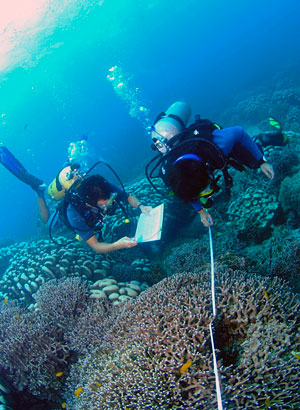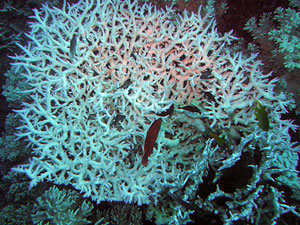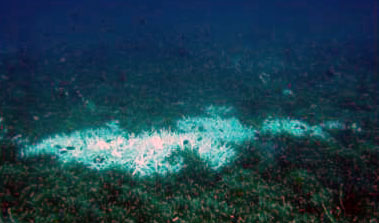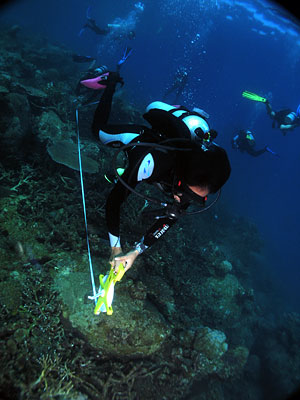
IN July 2010, several popular dive sites in Peninsular Malaysia were closed due to coral bleaching. Marine Park Department director-general Abd Jamal Mydin told reporters that in Pulau Payar in Kedah for example, an estimated 60% to 90% of corals were affected by the bleaching. Besides the peninsula, signs of coral bleaching have also been reported in Sepanggar Bay, Sabah.
Reef Check Malaysia general manager Julian Hyde tells The Nut Graph that the bleaching was first observed in April 2010, and the situation got worse in May and June. However, he says some divers have observed that the colours have returned to some of the corals in the past two to three weeks. “Contrary to popular belief, bleached corals are not necessarily dead. The decision to close down some of the popular sites is a short-term measure to reduce stress on the corals and thus increase their chances of recovering from the bleaching,” says Hyde in a phone interview.
But why are our corals bleaching? And why should we care what happens to them?
Stressed and threatened
Hyde says coral bleaching may happen when corals are stressed due to a variety of reasons that include increased sea temperature and pollution. However, mass bleaching is usually linked to high water temperature.
“Corals are very sensitive; a rise in 1°C to 2°C may cause them to bleach. When temperature increases, the symbiotic micro algae that live within corals will begin to release toxic molecules. Apart from providing the corals with food, these algae, called zooxanthellae, are what give the corals their colours.
“Consequently, the zooxanthellae are expelled from the corals’ tissue and the corals turn white,” Hyde explains. He adds that the corals can survive for several weeks if water temperature goes down in time and the zooxanthellae returns.
However, prolonged high water temperature may severely damage the corals and their ecosystems. During the El Nino and La Nina events in 1997 and 1998, mass bleaching and mortality were reported in coral reefs worldwide.
Apart from bleaching, our corals are also threatened by other human activities that could directly damage the reefs such as dynamite and cyanide fishing that happens in Sabah and tourists who carelessly touch, break or step on the corals.
Water pollution and coastal development that leads to soil erosion are also making it harder for our coral reefs to survive and flourish.
Why should we care?

Southeast Asia reportedly contains the largest area of coral reefs in the world. In addition, Malaysia is located in the Coral Triangle together with Indonesia, Papua New Guinea, the Solomon Islands, Timor-Leste and the Philippines.
In fact, the biodiversity of coral reefs in Southeast Asia is unparalleled according to the Global Coral Reef Monitoring Network in their 2008 report on the status of coral reefs worldwide.
Additionally, the marine parks in Peninsular Malaysia have been receiving 400,000 to 550,000 visitors per year since 2000. Hence, the reefs also help to generate tourism revenue.
Coral reefs and their vicinity also supply over 50% of our seafood, according to Malaysia’s Marine Park Department. “Over 3,000 marine species live in our reefs, and from this breeding ground comes half of our seafood supply,” it says on its site.
The department adds that medicine for cancer treatment and heart disease have also been discovered in bioactive compounds produced in coral reefs.
Careless tourists
Despite that, many snorkelers and divers couldn’t seem to care less what they do to our corals as long as they have fun. “I’ve seen some divers leaning on the corals to take photographs,” says marine biology graduate student Lau Chai Ming from Universiti Malaya. He adds that even though he signals the divers not to touch the corals or pull them away, many don’t get the message.

Responsible tourists are not supposed to touch, lean or stand on the reefs as they might break the corals that take hundreds or even thousands of years to form the structures seen today.
In May 2010, the Terengganu government said it planned to limit the annual number of tourists visiting Redang Island because the increasing number of tourists was taking a toll especially on the coral reefs.
Greenfins Malaysia was also set up in 2008 to encourage dive operators and their clients to adopt environmentally-friendly practices to help conserve coral reefs and marine life.
Alive vs dead

Reef Check Malaysia eco-diver Shafinaz Suhaimi says her most memorable experience when conducting reef surveys are the encounters with diverse marine life.
“Healthy reefs are bursting with marine life, sometimes turtles or a school of juvenile barracudas (ray-fined fish) would swim past us while we’re laying the transect line (to conduct the survey).
“I’ve also seen cuttlefish mating, and once I was almost attacked by a Titan triggerfish — they are very territorial when they are mating and nesting,” says Shafinaz, who has been conducting reef checks in Perhentian, Tioman and other islands on the east coast of the peninsula since 2007.
“The most exciting is when we see endangered species like sharks or the barramundi cod which have been severely fished out,” adds Shafinaz.
She says that the part of the survey she dislikes is when the transect line comes across dead reefs or marine life. “The survey can be done in less than an hour as there will be nothing much left to observe and record.” ![]()
JK Rowling once wrote in Harry Potter and the Goblet of Fire: “If you want to know what a [person is] like, take a good look at how he [or she] treats his [or her] inferiors, not his [or her] equals.” Gan Pei Ling thinks the same could apply to how we treat our corals.
The Nut Graph needs your support


Sean says
“JK Rowling”
Isn’t that Matthew 25:45 translated into pre-literate English?
Part of what attracts the tourists to South East Asia is precisely the opportunity to destroy (perhaps unintentionally) the thing they came to see. I was gob-smacked by my first visit to Angkor Wat: initially by the sheer scale and beauty of it, but quickly after by the fact that I could walk on it and touch it. Conservation in the home countries from where many visitors will come consists of total exclusion zones and severe penalties for even breathing on the subjects of conservation.
Rather than allowing visitors to trash your crown jewels, would it not be a good idea to invest in brightening up your lower-rank attractions to distract tourists while you do with your coral reefs what their home countries do with their greatest treasures? I think Malaysia doesn’t expertly (‘expertly’ here having the meaning of “not building colossal concrete skyscrapers in places which previously had some natural attraction”) capitalise on its common-or-garden jungle and beaches.
kohlfuzion says
Ok, so we have the facts on contributory causes to coral bleaching. The question is, what can we do about it?
1) Rising sea temperature
The environment is a zero sum game, some win, some lose. Our corals die because the water gets warmer, elsewhere corals thrive for the same reason. Skimping on an individual basis is not going to do anything when the world’s leaders can’t even commit. Recycling our organics may feel good but is not going to help as much as booting out the leaders and voting more responsible policies.
2) Pollution
Sediments & chemical runoffs kill corals. Mainly from land use management. The powers that be hold sway over this although they would very much like us to believe that it is our lifestyle that is to blame.
3) Physical damage
Actual physical damage like breaking off or ploughing into corals causes immediate destruction, but it is arguable that if the patch is left alone long enough, it can rejuvenate, all things unchanged. Veteran and regular divers would surely be well versed to steer clear of such damages because it is also in their interest to protect these corals for their continued enjoyment. It is the occasional divers who are most prone to commit the most damages. Some of the means to manage this: strict enforcement on protecting gazetted spots and regulate dive operators.
These are personal opinions only but the intent is to stir up some critical thinking about the state of the environment and what we can truly do as an individual. Recycling paper and avoiding plastics is not going to cut it. Spot and deny greenwash.